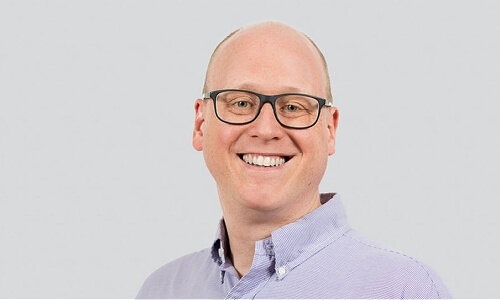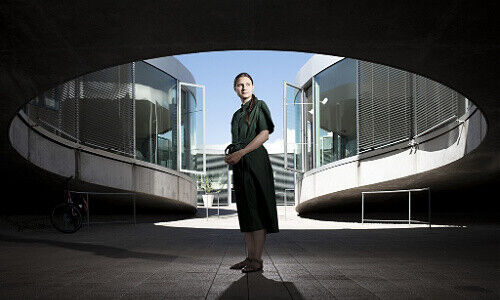The Fields Medal is awarded in recognition of outstanding mathematical achievements and the promise of future accomplishments. Now a second woman has received this mathematical honor. She is Ukrainian and teaches in Lausanne as Lars Jaeger writes in his finews.first article.
This article is published on finews.first, a forum for authors specializing in economic and financial topics.
The Fields Medal is awarded to recognize outstanding mathematical achievement for existing work and for the promise of future achievement. Out of a total of about 60 people, only one woman had so far managed to receive these highest honors for spectacular new mathematical discoveries. This was Maryam Mirzakhani, who received this award in 2014 (and died of cancer in 2017).
Now a second woman has received this highest mathematical award (Nobel prizes do not exist for mathematics, after all, the founder Alfred Nobel thought at the end of the 19th century that mathematics was not so important for practical purposes, something he would hardly have believed 25 years later. There are also rumors that he was angry with the mathematician Magnus Gösta Mittag-Leffler for having an affair with the great mathematician Sofja Kowalevskaja – which is not true).
«Number theory is considered by mathematicians to be the crowning field of their discipline»
The woman receiving the second Fields Medal is the 37-year-old Ukrainian Maryna Viazovska, holder of the Chair for Number Theory at the Swiss EPFL
Number theory is considered by mathematicians to be the crowning field of their discipline. She was rewarded for solving a problem that can be explained quite clearly at first sight: It is the so-called sphere-packing problem that had preoccupied mathematicians for more than four centuries: how to pack spheres like oranges as tightly as possible (using the smallest volume)?
In 1611, Johannes Kepler proposed the hypothesis that the densest type is the pyramid-shaped one stacked on top of the other – but had to leave this hypothesis unproven. This hypothesis was not finally proven before 1998 (for which a computer had to be used, which did not please all colleagues who would have liked to have «real proof»).
«The way spheres are packed in these special dimensions is remarkably symmetrical»
The volume is then a little more than 74 percent filled with spheres – more is not possible. Now the mathematicians, including Maryna Viazovska, wondered whether this statement could also be proven for higher dimensions.
«Formulating the problem, in the same way, complicates matters because each dimension is different, and the optimal solution depends very much on the dimension,» says Viazovska. Why did she focus on 8 and 24 dimensions? «Because these are special dimensions, and the solutions are particularly elegant.» The way spheres are packed in these special dimensions is remarkably symmetrical.
More than a decade ago, her colleagues Henry Cohn (MIT/Microsoft Research) and Noam Elkies (Harvard) found that particularly efficient sphere packing could be constructed in certain configurations of space, in the so-called E8 lattice for eight-dimensional space, and the so-called Leech lattice, a 24-dimensional lattice.
«A fact that makes her proof particularly elegant and original, according to experts»
However, they were unable to develop proof that these are minimal packages. Brilliant work by Viazovska provided the missing ingredient and showed that these lattices are indeed the densest possible packing patterns in their respective dimensions.
Back in 2016, Maryna Viazovska proved in a paper of only 23 pages that the E8 lattice realizes the densest sphere packing in eight-dimensional space (R8) when spheres of equal radii are placed around each of the lattice points.
Her proof was considerably simpler than that of Kepler’s corresponding 3-dimensional problem. For this, she used a certain function composed of modular forms, in the search for which she drew on other areas of mathematics – a fact that makes her proof particularly elegant and original, according to experts.
Driven by creativity and intuition, Viazovska oriented herself towards the focus of her dissertation: modular forms, a type of mathematical function with a particularly high degree of symmetry.
«This proof was cheered by the mathematical community»
After two years of work, she had found the right function for eight dimensions. Only one week later, Viazovska (with colleagues Cohn, Kumar, Miller, and Radchenko) then proved with similar methods as in the eight-dimensional case in a 17-page paper that the Leech lattice provides the optimal sphere packing in the 24-dimensional space R24.
This finally confirmed the significance of their original proof for 8 dimensions. This proof was cheered by the mathematical community and earned Viazovska a number of prestigious awards. «This is actually a very useful tool used in many areas of technology,» she told newswire «AP».
«Mathematics always seemed like the most straightforward subject
Viazovska was born on Dec. 2, 1984, in Kyiv, Ukraine. Because she developed a passion for mathematics at a young age, her path to the subject was relatively easy. «I’ve liked mathematics since my schooldays,» she says. «It always seemed like the most straightforward subject. And since I liked it, I spent more time on it, and eventually became better at math than other subjects. So then I liked it even more, and so on.»
After earning her Bachelor's degree at the National Taras Shevchenko University in Kyiv, Viazovska went to Germany to earn a Master's degree at the Technical University of Kaiserslautern (2007) before moving to the University of Bonn, where she completed her doctorate on modular forms in 2013.
«Like a jigsaw puzzle»
During her postdoctoral research at the Berlin Mathematical School and the Humboldt University of Berlin, Viazovska tackled and solved the sphere packing problem in 8 and 24 dimensions. Then, in December 2016, she accepted an offer from EPFL to become an assistant professor with tenure-track status. Just one year later, at the age of 33, she was promoted to full professor.
What drives Viazovska is solving problems, which she describes as «doing a jigsaw puzzle», and understanding abstract concepts «so I can link them to other problems and find practical applications.» She is not, however, independent of politics. For example, she also says that Russia’s invasion of Ukraine on Feb. 24 profoundly changed her life and that of all Ukrainians.

Lars Jaeger is a Swiss-German author and investment manager. He writes on the history and philosophy of science and technology and has in the past been an author on hedge funds, quantitative investing, and risk management.
Previous contributions: Rudi Bogni, Peter Kurer, Rolf Banz, Dieter Ruloff, Werner Vogt, Walter Wittmann, Alfred Mettler, Robert Holzach, Craig Murray, David Zollinger, Arthur Bolliger, Beat Kappeler, Chris Rowe, Stefan Gerlach, Marc Lussy, Nuno Fernandes, Richard Egger, Maurice Pedergnana, Marco Bargel, Steve Hanke, Urs Schoettli, Ursula Finsterwald, Stefan Kreuzkamp, Oliver Bussmann, Michael Benz, Albert Steck, Martin Dahinden, Thomas Fedier, Alfred Mettler, Brigitte Strebel, Mirjam Staub-Bisang, Nicolas Roth, Thorsten Polleit, Kim Iskyan, Stephen Dover, Denise Kenyon-Rouvinez, Christian Dreyer, Kinan Khadam-Al-Jame, Robert Hemmi, Anton Affentranger, Yves Mirabaud, Katharina Bart, Frédéric Papp, Hans-Martin Kraus, Gerard Guerdat, Mario Bassi, Stephen Thariyan, Dan Steinbock, Rino Borini, Bert Flossbach, Michael Hasenstab, Guido Schilling, Werner E. Rutsch, Dorte Bech Vizard, Adriano B. Lucatelli, Katharina Bart, Maya Bhandari, Jean Tirole, Hans Jakob Roth, Marco Martinelli, Thomas Sutter, Tom King, Werner Peyer, Thomas Kupfer, Peter Kurer, Arturo Bris, Frederic Papp, James Syme, Dennis Larsen, Bernd Kramer, Armin Jans, Nicolas Roth, Hans Ulrich Jost, Patrick Hunger, Fabrizio Quirighetti, Claire Shaw, Peter Fanconi, Alex Wolf, Dan Steinbock, Patrick Scheurle, Sandro Occhilupo, Will Ballard, Nicholas Yeo, Claude-Alain Margelisch, Jean-François Hirschel, Jens Pongratz, Samuel Gerber, Philipp Weckherlin, Anne Richards, Antoni Trenchev, Benoit Barbereau, Pascal R. Bersier, Shaul Lifshitz, Klaus Breiner, Ana Botín, Martin Gilbert, Jesper Koll, Ingo Rauser, Carlo Capaul, Claude Baumann, Markus Winkler, Konrad Hummler, Thomas Steinemann, Christina Boeck, Guillaume Compeyron, Miro Zivkovic, Alexander F. Wagner, Eric Heymann, Christoph Sax, Felix Brem, Jochen Moebert, Jacques-Aurélien Marcireau, Ursula Finsterwald, Claudia Kraaz, Michel Longhini, Stefan Blum, Zsolt Kohalmi, Karin M. Klossek, Nicolas Ramelet, Søren Bjønness, Gilles Prince, Salman Ahmed, Peter van der Welle, Ken Orchard, Christian Gast, Jeffrey Bohn, Juergen Braunstein, Jeff Voegeli, Fiona Frick, Stefan Schneider, Matthias Hunn, Andreas Vetsch, Fabiana Fedeli, Marionna Wegenstein, Kim Fournais, Carole Millet, Swetha Ramachandran, Thomas Stucki, Neil Shearing, Claude Baumann, Tom Naratil, Oliver Berger, Robert Sharps, Tobias Mueller, Florian Wicki, Jean Keller, Niels Lan Doky, Karin M. Klossek, Johnny El Hachem, Judith Basad, Katharina Bart, Thorsten Polleit, Bernardo Brunschwiler, Peter Schmid, Karam Hinduja, Zsolt Kohalmi, Raphaël Surber, Santosh Brivio, Mark Urquhart, Olivier Kessler, Bruno Capone, Peter Hody, Andrew Isbester, Florin Baeriswyl, and Michael Bornhaeusser, Agnieszka Walorska, Thomas Mueller, Ebrahim Attarzadeh, Marcel Hostettler, Hui Zhang, Michael Bornhaeusser, Reto Jauch, Angela Agostini, Guy de Blonay, Tatjana Greil Castro, Jean-Baptiste Berthon, Marc Saint John Webb, Dietrich Goenemeyer, Mobeen Tahir, Didier Saint-Georges, Serge Tabachnik, Vega Ibanez, David Folkerts-Landau, Andreas Ita, Teodoro Cocca, Michael Welti, Mihkel Vitsur, Fabrizio Pagani, Roman Balzan, Todd Saligman, Christian Kaelin, Stuart Dunbar, Carina Schaurte, Birte Orth-Freese, Gun Woo, Lamara von Albertini, Philip Adler, Ramon Vogt, Andrea Hoffmann, Niccolò Garzelli, Darren Williams, Benjamin Böhner, Mike Judith, Jared Cook, Henk Grootveld, Roman Gaus, Nicolas Faller, Anna Stünzi, Thomas Höhne-Sparborth, Fabrizio Pagani, Taimur Hyat, Ralph Ebert, Guy de Blonay, Jan Boudewijns, Beat Wittmann, Sean Hagerty, Alina Donets, Sébastien Galy, Lars Jaeger, Roman von Ah, Fernando Fernández, Georg von Wyss, Stéphane Monier, Stefan Bannwart, Andreas Britt, Frédéric Leroux, Nick Platjouw, Rolando Grandi, Philipp Kaupke, Gérard Piasko, Brad Slingerlend, Dieter Wermuth, Grégoire Bordier, Thomas Signer, Brigitte Kaps, and Gianluca Gerosa.


































